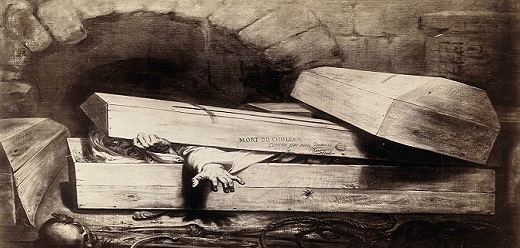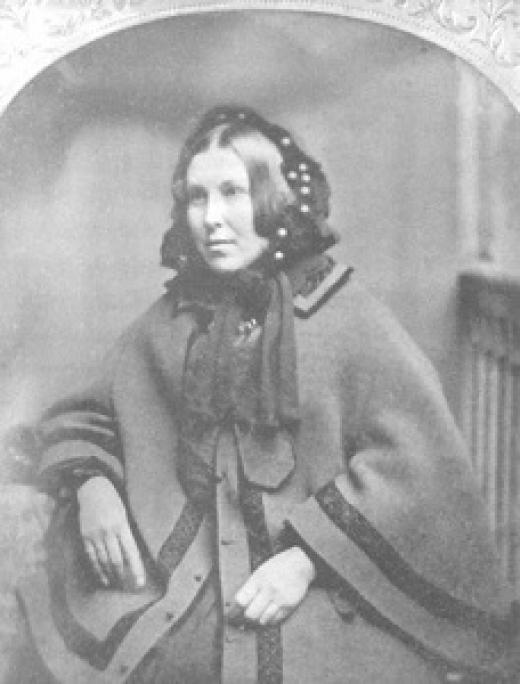
https://wellcomecollection.org/works/h94tevfb/images?id=cgj8g8b6
Life under lockdown: the 1832 cholera epidemic as seen by Charlotte Stoker
Today Sligo, like all other towns and cities in Ireland, is largely shuttered and empty thanks to the government’s COVID-19 restrictions. The last time Sligo was deserted under similar circumstances was in 1832, when people were too terrified to leave their homes due to contagion. At that time a girl called Charlotte Thornley (1818-1901) then aged 14, was in lockdown with her family during the great cholera pandemic. Charlotte would go on to write Experiences of the cholera in Ireland (1873) an unpublished account currently held in the Special Collections Library of TCD.[1] This document is not only a valuable and credible first-hand historic account but some of the gruesome details clearly influenced the literary output of Charlotte’s son, the author Bram Stoker. On its own Experiences is worth analysing as a compelling description of the fear, panic and peoples’ reactions to a pandemic and life under lockdown, some of which will sound familiar to us today.
Cholera, a novel disease
Like COVID-19, 'Asiatic Cholera' was a disease new to Europe, rampant on the continent since 1831. In Experiences Charlotte described the wait for cholera to inevitably appear in their town as a “dread” as they heard “of the new and terrible plague which was desolating all lands as it passed through them.” People heard reports of how cholera offered an agonising and undignified death within hours. In an age where most scientists subscribed to miasmic theory people did not stand a chance against cholera. There was no cure and little effective treatment.
“It’s utter strangeness and man’s want of experience or knowledge of its nature, or how best to resist its attack, added if anything could to its horrors”- Stoker, Experiences.
By 1832, it was coming closer to home and Charlotte wrote “with wild affright we began to hear a whisper pass 'It was in Ireland'”. By August, cholera was in Sligo and took its first official victim on the 11th - the same date that Count Dracula took his first victim on English soil in Bram Stoker’s 1897 novel. Within six weeks, it is thought, the lives of up to 1500 people were claimed by the disease in the town. Sligo was declared the worst affected town in all of Ireland or Britain that year.
Lockdown during cholera
To middle class protestants like the Thornley family cholera had an added fear factor – it affected people in good health and wealth, and their privilege would not offer them the immunity to the various famines and fevers that had previously torn through the poorer population.
Cholera took its victims swiftly. Charlotte told of visiting their friends the Holmes family who consisted of three adults and eight children: “we left them all well at half past nine, and the next morning at 9 o’clock we heard that [six of the family] were dead and [had already been] buried.”
“In a very few days the town became like a city of the dead” - Stoker, Experiences.
The town became deserted, businesses shut, people stayed indoors with “no vehicles except the Cholera carts or Doctor carriages”. The protestant clergy largely fled the town and wakes were suspended. Riots were threatened. In Sligo the sounds of the cries of the bereaved women and children were audible in the streets.
As the outbreak intensified the Thornley’s ceased to leave their home. They had a cow and hens in their back yard which afforded them some self-sufficiency as there were food shortages in the town. Charlotte’s mother Matilda would leave jugs of milk out on the doorstep for her poorer neighbours. Other than this there was little contact with the outside world. Despite being asked not to, a salesman still knocked each morning on the Thornley’s door to ask if coffins were needed, a rudeness Charlotte described as “a climax hard to bear, few nerves could stand it”. Eventually she upended a jug of water on his head.

https://sligowalkingtours.com/charlotte-thornley-stoker/
“By twos and threes our dead neighbours were carried away. One morning […] four were carried at once dead out of the opposite house” - Stoker, Experiences.
Charlotte tells of a child in the next house who, her parents having died, “was left alone sick, and we could hear her crying. I begged my mother’s leave to help her. She let me go with many tears. Poor Mary died in my arms an hour after and I returned home, and being well fumigated was taken in and escaped [without catching the disease]”.
The Thornley family hunkered down behind the closed doors of their home: “every morning at daybreak, a cry used to go from room to room over the house, is anyone dead, but we were mercifully spared.” The local historian and expert Dr Fìona Gallagher has speculated that geography saved the Thornleys from the cholera-contaminated river water, as their house on elevated Old Market Street likely had a clean well.
The futile fight against cholera
Charlotte describes her family taking whiskey with ginger as a prophylactic and their “store of cholera medicines (without which no one moved a yard)”. But we know these were hopeless. Sligo’s Board of Health had trenches dug across roads to halt the disease, but it was as Charlotte said “no use, no use!”
“At night many tar barrels and other combustible matters used to be burned along the street to try and purify the air, and had a weird unearthly look, gleaming out in the darkness” - Stoker, Experiences.
All this did was to create a “heavy sulphurous looking cloud” which hung over the town and killed all the birds, whose bodies were found on the shores of nearby Lough Gill. Did these destructive red eyes later haunt her son’s imagination? There is so much in Experiences and its history that parallels Dracula that led me to propose elsewhere that Bram Stoker shaped Count Dracula in the image of Sligo’s cholera.[2]
The horrors of Sligo Fever Hospital
Wherever cholera struck in Europe in 1832 there were similar scenes and rumours about what went on behind the doors of the hospitals and they became feared places. The persistent rumour everywhere was of live burials, both by accident and design.
All places with cholera were affected by riots, conspiracy theories and general mistrust of doctors and the medical establishment. Some people behaved with a depravity driven by fear. Charlotte wrote of “deeds done (in selfish dread)”. She heard of “a poor traveller was taken ill on the roadside […] and how did those Samaritans tend him? They dug a pit and with long poles pushed him living into it and covered him up alive.”
Sligo was notable for its loss of many doctors and nursing staff. Their replacements Charlotte called “women of the worst description, who were always more than half drunk” and described the local Fever Hospital as a place where “such scenes were perpetuated […] as would make the flesh creep to hear of”. Of the mass grave there, Charlotte wrote “many were said to be buried alive”. Cholera patients “who were stupefied from opium and nearest death [were removed to the mass grave] to make room for the new arrivals.” A Roman Catholic priest, Fr Gilern told her of having to attend the hospital armed with a horse whip to protect cholera patients from such abuse.
Charlotte recounted that one man took what he thought was the corpse of his wife out of the hospital mass grave to give her a proper burial, only to find she was still alive. A tall soldier, seemingly deceased from cholera, was having his legs broken to fit him into a coffin only for him to awake. Both cases lived many years afterward.
Conclusion
At the time of writing we are in lockdown during a pandemic and our society is familiar with epidemiology thanks to the huge advances in science in recent years. We know what COVID-19 looks like via a microscope, what we can do to prevent catching it and how medicine is responding to it. In 1832, people had no understanding of viruses or their treatment. Cholera ran rampant and it seemed like a curse from God. Many believed it was supernatural, with one Dublin chaplain describing it as “a pestilence, which walketh in the darkness”. The fear and panic of Sligo during cholera in 1832 was such that even lockdown could not be tolerated, and most people fled the town.
The Thornley family lasted two weeks in this febrile environment. The crux came when Charlotte’s mother went into their yard to find their hens dead and took it as an ominous sign to leave. The family evacuated to nearby Ballyshannon where they had relatives. That journey was fraught with difficulty, but they survived and came back to Sligo when the epidemic abated, to find the streets “grass grown” and much of the population dead.
At the end of her essay, Charlotte thanked “God, who had spared us through such dangerous and trying times and scenes.” She cannot fail to have been traumatised, but she went on to lead a successful life, marrying and moving to Dublin, where she had children. She often spoke up for people with disabilities and the poor. She should be remembered not just because of her famous sons but because she was a remarkable woman in her own right. Her Experiences stands up as a credible historical account, and her details tally with many established facts: Mr Holmes is in the parish death register, Fr Gilern is mentioned in other accounts, Dr Little was their neighbour, the mass grave sites are still there, and so on.
In 2019 I, and other members of Sligo Stoker Society, had Charlotte’s account published in full in order to make it more accessible to the public. It is currently displayed at various cholera-linked locations in Sligo town: Sligo Abbey, St John’s Cathedral, Sligo University Hospital, Sligo Library and the Yeats memorial building, themselves shuttered off to the public because of the current pandemic. I wonder what Charlotte would make of it all?
Further reading
For more on Sligo’s 1832 cholera epidemic see Dr Fiona Gallagher’s blog:
https://drfionagallagher.weebly.com/
For more see Sligo Walking Tours blog https://sligowalkingtours.com/sligo-dracula-tour/
[1] MS 11076/2/3 Typescript transcription of an account of the cholera outbreak in Ireland in 1832, originally written by Charlotte Stoker in Caen, May 1873.
[2] McGarry, M. (2020) ”Cholera = Dracula: the influences of Sligo’s cholera epidemic of 1832 on Bram Stoker’s novel Dracula (1897)" in Journal of Medical Humanities special edition entitled 'Epidemics and Disease in Ireland; Literature, Culture, Histories', forthcoming.


